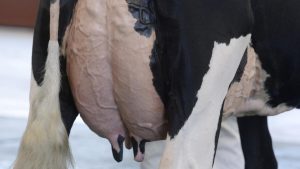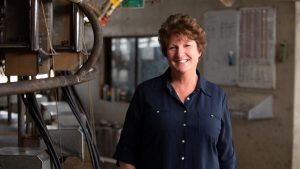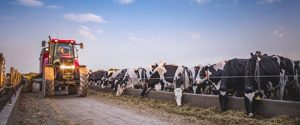
Key points:
The dairy is off the grid with solar providing power for all activities
Cows are monitored and fed during milking
A robotic system offers farmers the chance to sleep in
It was during a family gathering several years ago that John and Kay Smith decided to make changes at one of their two farms on the outskirts of Bulahdelah.
Mr Smith said the traditional “10-a-side Herringbone” dairy system was inefficient.
“It was costing us time and money, ” he said.
“Our first thought was what could we do to upgrade that dairy and make it more productive.”
He said after a lot of investigation, a robotic dairy appealed as a good option.
“It seemed to offer us a lot of opportunities that the conventional dairy didn’t, so we decided that would be the plan,” Mr Smith said.
Cows’ production and health monitored
It is the middle of the day and some of the herd are walking through a series of gates heading to the milking bays in the Swedish-built technology.
The key to getting a cow to enter the dairy is a brush the animal pushes up against that triggers a rub along its back and flanks.
The cows stop to enjoy the sensation before heading to the milking bays.
Once in, they start feeding while a laser checks their udders.
Warm water is sprayed to clean their teats, and a mechanised arm puts the cups on.
During the milking, a computer gives real-time readings of output and compares it to the cow’s average.
This enables close monitoring of the cow’s health and checks for potential problems.
Once finished, the cows leave through a series of gates channelling them to another paddock.
Steep learning curve
There is a minimum of seven hours between milking sessions.
If the cows wander up for a feed and a brush before that time has elapsed, it is detected through an ear tag and the gates refuse to open.
Presently about 100 cows are being milked each day, with the target set at 200.
“There is the potential for the cows to be milked three times a day, but that is not a target we have set,” Mr Smith said.
“At present, the cows have been on a steep learning curve, but I may say not as much as Kay and me.”
Solar does its job
All of this is achieved with the use of solar power.
Consultant Nick Bullock has worked closely with the family.
He said a key part of the design was using solar panels on the roof to replenish batteries.
“It was a question of getting the right components and right people to design the system, ” Mr Bullock said.
“It’s not a question of buying a chiller off the shelf.
“With a conventional dairy you have a spike in the early morning and again in the afternoon of energy use.
“With this, we can shift energy use around.”
Looking after the environment
The property has been reconfigured to allow the cows to move to and from the dairy.
That was when Local Land Services officer Kirby Byrne became involved.
“When we were looking at sub-dividing paddocks, we really had to look at how to ensure that the wetlands and the vegetation along the Myall River can be looked after,” she said.
“This is a privately owned property and the landholder needs to be happy.”
Ms Byrne said the Smiths were conscious of the environment.
“There are benefits for them such as stock not getting into the river or getting into the wetlands,” she said.
“Getting muddy udders and health issues can occur if they get into the wetlands.”
Mr Smith is no longer locked into rising at around 5:30am, sometimes sleeping in until 7:00am.
“Looking out the front of the house, I can see a line of cows finding their way up to the dairy and I can look on my mobile phone and it tells me how many cows have already been milked when looking out that window,” he said.























